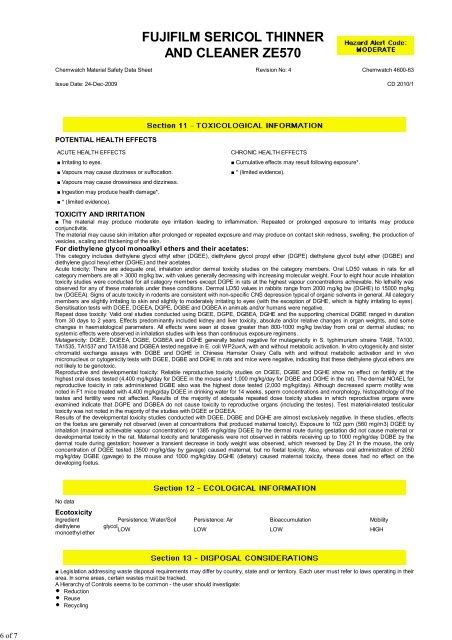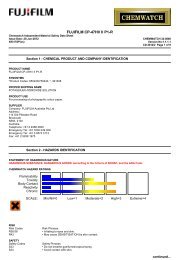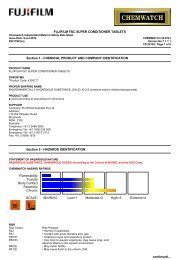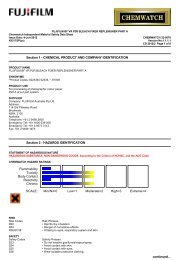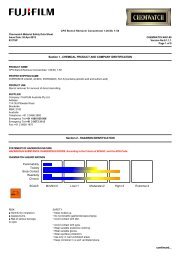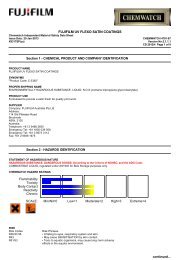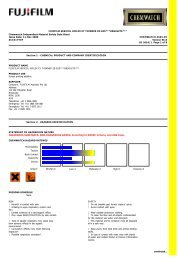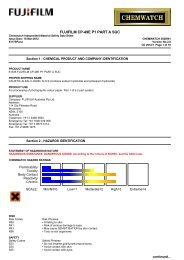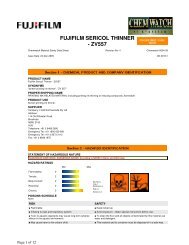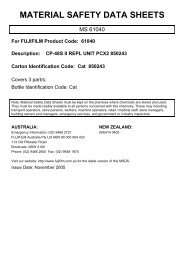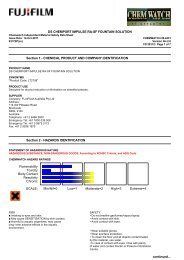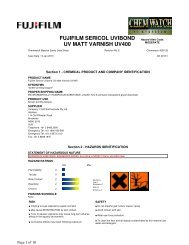fujifilm sericol thinner and cleaner ze570 - FUJIFILM Australia
fujifilm sericol thinner and cleaner ze570 - FUJIFILM Australia
fujifilm sericol thinner and cleaner ze570 - FUJIFILM Australia
Create successful ePaper yourself
Turn your PDF publications into a flip-book with our unique Google optimized e-Paper software.
6 of 7<br />
<strong>FUJIFILM</strong> SERICOL THINNER<br />
AND CLEANER ZE570<br />
Chemwatch Material Safety Data Sheet Revision No: 4 Chemwatch 4600-63<br />
Issue Date: 24-Dec-2009 CD 2010/1<br />
POTENTIAL HEALTH EFFECTS<br />
ACUTE HEALTH EFFECTS<br />
■ Irritating to eyes.<br />
■ Vapours may cause dizziness or suffocation.<br />
■ Vapours may cause drowsiness <strong>and</strong> dizziness.<br />
■ Ingestion may produce health damage*.<br />
■ * (limited evidence).<br />
CHRONIC HEALTH EFFECTS<br />
■ Cumulative effects may result following exposure*.<br />
■ * (limited evidence).<br />
TOXICITY AND IRRITATION<br />
■ The material may produce moderate eye irritation leading to inflammation. Repeated or prolonged exposure to irritants may produce<br />
conjunctivitis.<br />
The material may cause skin irritation after prolonged or repeated exposure <strong>and</strong> may produce on contact skin redness, swelling, the production of<br />
vesicles, scaling <strong>and</strong> thickening of the skin.<br />
For diethylene glycol monoalkyl ethers <strong>and</strong> their acetates:<br />
This category includes diethylene glycol ethyl ether (DGEE), diethylene glycol propyl ether (DGPE) diethylene glycol butyl ether (DGBE) <strong>and</strong><br />
diethylene glycol hexyl ether (DGHE) <strong>and</strong> their acetates.<br />
Acute toxicity: There are adequate oral, inhalation <strong>and</strong>/or dermal toxicity studies on the category members. Oral LD50 values in rats for all<br />
category members are all > 3000 mg/kg bw, with values generally decreasing with increasing molecular weight. Four to eight hour acute inhalation<br />
toxicity studies were conducted for all category members except DGPE in rats at the highest vapour concentrations achievable. No lethality was<br />
observed for any of these materials under these conditions. Dermal LD50 values in rabbits range from 2000 mg/kg bw (DGHE) to 15000 mg/kg<br />
bw (DGEEA). Signs of acute toxicity in rodents are consistent with non-specific CNS depression typical of organic solvents in general. All category<br />
members are slightly irritating to skin <strong>and</strong> slightly to moderately irritating to eyes (with the exception of DGHE, which is highly irritating to eyes).<br />
Sensitisation tests with DGEE, DGEEA, DGPE, DGBE <strong>and</strong> DGBEA in animals <strong>and</strong>/or humans were negative.<br />
Repeat dose toxicity: Valid oral studies conducted using DGEE, DGPE, DGBEA, DGHE <strong>and</strong> the supporting chemical DGBE ranged in duration<br />
from 30 days to 2 years. Effects predominantly included kidney <strong>and</strong> liver toxicity, absolute <strong>and</strong>/or relative changes in organ weights, <strong>and</strong> some<br />
changes in haematological parameters. All effects were seen at doses greater than 800-1000 mg/kg bw/day from oral or dermal studies; no<br />
systemic effects were observed in inhalation studies with less than continuous exposure regimens.<br />
Mutagenicity: DGEE, DGEEA, DGBE, DGBEA <strong>and</strong> DGHE generally tested negative for mutagenicity in S. typhimurium strains TA98, TA100,<br />
TA1535, TA1537 <strong>and</strong> TA1538 <strong>and</strong> DGBEA tested negative in E. coli WP2uvrA, with <strong>and</strong> without metabolic activation. In vitro cytogenicity <strong>and</strong> sister<br />
chromatid exchange assays with DGBE <strong>and</strong> DGHE in Chinese Hamster Ovary Cells with <strong>and</strong> without metabolic activation <strong>and</strong> in vivo<br />
micronucleus or cytogenicity tests with DGEE, DGBE <strong>and</strong> DGHE in rats <strong>and</strong> mice were negative, indicating that these diethylene glycol ethers are<br />
not likely to be genotoxic.<br />
Reproductive <strong>and</strong> developmental toxicity: Reliable reproductive toxicity studies on DGEE, DGBE <strong>and</strong> DGHE show no effect on fertility at the<br />
highest oral doses tested (4,400 mg/kg/day for DGEE in the mouse <strong>and</strong> 1,000 mg/kg/day for DGBE <strong>and</strong> DGHE in the rat). The dermal NOAEL for<br />
reproductive toxicity in rats administered DGBE also was the highest dose tested (2,000 mg/kg/day). Although decreased sperm motility was<br />
noted in F1 mice treated with 4,400 mg/kg/day DGEE in drinking water for 14 weeks, sperm concentrations <strong>and</strong> morphology, histopathology of the<br />
testes <strong>and</strong> fertility were not affected. Results of the majority of adequate repeated dose toxicity studies in which reproductive organs were<br />
examined indicate that DGPE <strong>and</strong> DGBEA do not cause toxicity to reproductive organs (including the testes). Test material-related testicular<br />
toxicity was not noted in the majority of the studies with DGEE or DGEEA.<br />
Results of the developmental toxicity studies conducted with DGEE, DGBE <strong>and</strong> DGHE are almost exclusively negative. In these studies, effects<br />
on the foetus are generally not observed (even at concentrations that produced maternal toxicity). Exposure to 102 ppm (560 mg/m3) DGEE by<br />
inhalation (maximal achievable vapour concentration) or 1385 mg/kg/day DGEE by the dermal route during gestation did not cause maternal or<br />
developmental toxicity in the rat. Maternal toxicity <strong>and</strong> teratogenesis were not observed in rabbits receiving up to 1000 mg/kg/day DGBE by the<br />
dermal route during gestation; however a transient decrease in body weight was observed, which reversed by Day 21 In the mouse, the only<br />
concentration of DGEE tested (3500 mg/kg/day by gavage) caused maternal, but no foetal toxicity. Also, whereas oral administration of 2050<br />
mg/kg/day DGBE (gavage) to the mouse <strong>and</strong> 1000 mg/kg/day DGHE (dietary) caused maternal toxicity, these doses had no effect on the<br />
developing foetus.<br />
No data<br />
Ecotoxicity<br />
Ingredient Persistence: Water/Soil Persistence: Air Bioaccumulation Mobility<br />
diethylene glycol<br />
LOW<br />
monoethyl ether<br />
LOW LOW HIGH<br />
■ Legislation addressing waste disposal requirements may differ by country, state <strong>and</strong>/ or territory. Each user must refer to laws operating in their<br />
area. In some areas, certain wastes must be tracked.<br />
A Hierarchy of Controls seems to be common - the user should investigate:<br />
Reduction<br />
Reuse<br />
Recycling


